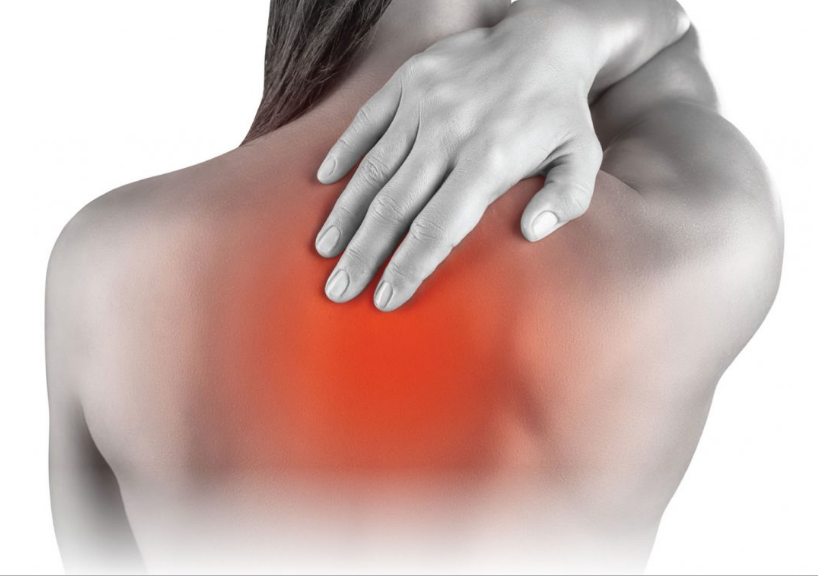Upper Back Pain

Upper Back Pain
Upper back pain may be less common than other spinal ailments, but for many men and women it is no less painful. This condition can manifest as acute or chronic discomfort and significantly affects the lives of those who experience it. The term upper back pain generally describes any pain occurring throughout the upper back area, including the shoulder blades and the region where the rib cage connects to the upper, mid-back and chest sections of the spine.
Upper Back Pain Symptoms
- Stiffness and tightness
- Muscle spasms
- Tenderness
- Pain through the neck and shoulders
- Numbness
- Bad posture
- Weakness
Upper Back Pain Causes
If the above symptoms sound familiar, there’s a good chance you are being afflicted by upper back pain. Many patients are surprised to learn the broad spectrum of factors that can spur upper back complications. The following determinants can contribute to upper back pain:
- Strained Muscles
The shoulder girdle is attached by large muscles to the scapula, or shoulder blade, and the back of the thoracic rib cage. These large upper back muscles are susceptible to irritation. When you over-stretch muscle tissue, damage often occurs. Tearing of the muscle and the disruption of small blood vessels can lead to tenderness, inflammation and swelling. Poor posture, a lack of exercise, a traumatic incident or improperly lifting heavy objects may induce harm.
- Injured Discs
Injured discs in the spinal column press against surrounding tissues and nerves, causing pain and other complications.
- Fractured Vertebrae
A damaged vertebrae in the cervical (neck) or thoracic (upper) regions of the spine may hinder motion and incite intense discomfort.
- Infection
Some serious bacterial infections, such as meningitis, can cause upper back pain.
- Osteoporosis
Hormonal changes and vitamin deficiencies can cause osteoporosis, a condition in which the bones become brittle and fragile from tissue loss. Weak bones are more likely to fracture or become injured, straining corresponding tissues and ligaments.
- Aging
Over time, the spine becomes vulnerable to deterioration and the body becomes less able to adapt quickly. Sometimes upper back pain results as tissues, ligaments and bones deal with damage and fluctuating weight distribution.
- Spinal Conditions, such as scoliosis
Certain complications, such as scoliosis, disrupt the structural integrity of the spine and cause pain.
- Health issues, like acid reflux or ulcers
Some health challenges can aggravate the vagus nerve, which extends into the upper back. Additionally, patients may sleep in specific positions to get relief from heartburn and other maladies, thus causing back pain.
- Joint Dysfunction
Ribs are connected to vertebrae in the thoracic spine by two joints, which fasten upon each side of the spine. When these joints do not function properly or become injured, discomfort results.
Upper Back Pain Non-Surgical Treatment Options
By locating the sources of your upper back pain, you can pursue effective treatment and often reduce the severity of your condition.
Begin keeping a pain journal and charting your symptoms and their triggers. If pain ceases after taking over-the-counter pain relievers or using a combination of ice packs and heat, your discomfort is most likely caused by strained muscles and will heal on its own.
Physical therapy, chiropractic manipulation and massage can also be helpful.
Upper Back Pain Minimally Invasive Treatment Options
For some patients more extensive treatment is required, likely because their pain is caused by a more enduring injury. At Microspine, Dr. T is here to help, every step of the way. We create customized, patient-centric plans that fit your unique needs and preferences.
Before deciding upon a specific approach to treatment, our expert may recommend an imaging study, such as an MRI, CT scan or X-ray. We also offer advanced pain mapping procedures that pinpoint and isolate the precise sources of discomfort in the neck and back. By discovering the underlying instigator of your upper back pain, our team can construct a strategy to directly address your unique condition.
Upper Back Pain Minimally Invasive Treatment Options
Certain types of upper back pain are responsive to physical therapy, massage and at-home treatments. If a fractured vertebrae or ruptured disc is causing your discomfort, however, minimally invasive surgery may be imperative to relief. As opposed to traditional open surgery, minimally invasive surgery involves making a minute incision. Because the procedure is so non-invasive, the surgical site generally scars very little, loses little blood and requires almost no recovery time.
Types of minimally invasive surgery relevant to upper back pain include:
- Microspine Endoscopic Discectomy
- Microspine Decompression
- MIS Spinal Fusion
Chronic upper back pain can decrease your quality of life and keep you from doing the things you love. Depending on the origin of your discomfort, delaying care may lead to lasting consequences, such as permanent nerve damage. Our team of spine specialists is ready to guide you through every step of the healing process, so you can live a full, pain-free life.
We look forward to helping you feel better, faster! CONTACT US
REQUEST APPOINTMENT
If you are suffering from low-back pain, neck pain, herniated disc, sciatica, pinched nerve and have been researching minimally invasive spine surgery as well as laser spine surgery, schedule an appointment to speak to Dr. T and Microspine Team today.
REQUEST APPOINTMENT
If you are suffering from low-back pain, neck pain, herniated disc, sciatica, pinched nerve and have been researching minimally invasive spine surgery as well as laser spine surgery, schedule an appointment to speak to Dr. T and Microspine Team today.
Microspine
Office
14300 N Northsight Blvd, #213. Scottsdale, AZ 85260
Phone: 602-833-2141
Fax: 602-610-3878
Office hours M-F: 8 AM to 5 PM
By appointment only
Dr. T serves the areas of Anthem, Apache Junction, Avondale, Buckeye, CasaGrande, Cave Creek, Chandler, Flagstaff, Fountain Hills, Gilbert, Glendale, Goodyear, Laveen, Maricopa, Mesa, Paradise Valley, Payson, Peoria, Phoenix, Prescott, Prescott Valley, Queen Creek, Safford, SanTan, Scottsdale, Sedona, Showlow, Suncity, Suncity West, Tempe, Tucson, Yuma, and surrounding areas.
